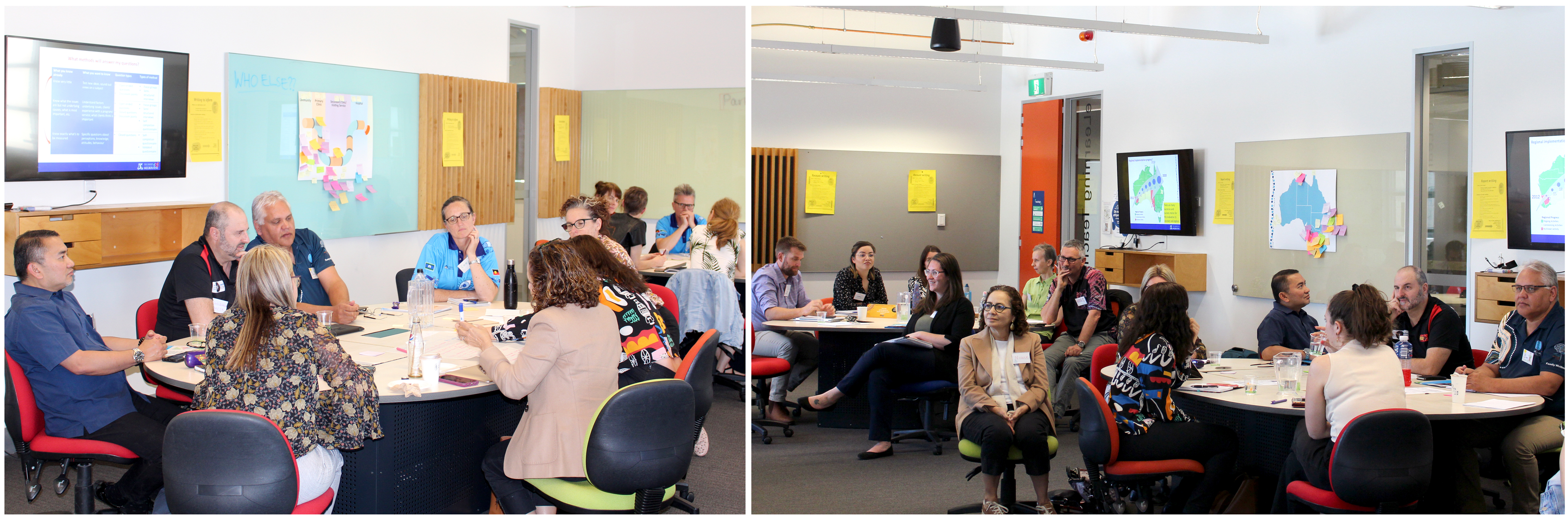Evaluation Co-design
To make sure that we were asking the right questions and using the best methods, the evaluation was co-designed with stakeholders from across Australia and the Aboriginal and Torres Strait Islander eye care pathway.
Participants in the co-design group were selected through an Expression of Interest process and represented: Aboriginal Community Controlled Organisations (health services); ACCHO Jurisdictional Peaks; National Indigenous Health Peak; Jurisdictional Fundholders; Not for Profit Eyecare Organisations; Optometry, Hospitals; and Universities. Over the course of the co-design process, there was representation from all States and Territories except the ACT.
Four facilitated co-design workshops were held over the course of the evaluation:
- Workshop 1: design the evaluation questions and methods: The first workshop, with 38 people from across the country and the pathway of care, was held in October 2019 (see Workshop 1)
- Workshop 2: provide input into interpretation of initial evaluation findings: The second workshop, with 32 people from across the country and the pathway of care was held on 8th December 2020.
- Workshop 3: contribute to shaping the findings and evaluation reports: The third workshop, with 28 people from across the country and the pathway of care was held on 25 May 2021.
- Workshop 4: developing a response to the evaluation findings and a knowledge exchange plan: The fourth workshop was held 28 September 2021, with 27 people from across the country and pathway of care.
Co-design group members also provided input via email to evaluation tools, communications and draft reports.
In addition, the Aboriginal and Torres Strait Islander Reference Group, formed in December 2019, provided ongoing guidance through meetings and out-of-session comment.
Participation in the evaluation
Opportunities were provided for stakeholders to contribute to the evaluation through the national survey and/or through interviews or through case study sites.
If you have any questions about the process or what was involved email Tessa.Saunders@unimelb.edu.au or call (03) 9035 3972
Workshop 1 October 2019
On Tuesday 29 October 2019, the first (of three) codesign workshops for the evaluation of the regional implementation of The Roadmap to Close the Gap for Vision was held at The University of Melbourne. The workshop was organised by Indigenous Eye Heath and facilitated by an external Aboriginal facilitator, Kate Kelleher, with the support of the evaluation team from ARTD Consultants.
The objectives of the workshop were to ensure participants understood their role in co-designing the evaluation and how they can be involved in the evaluation and to reach broad agreement on:
- what ‘success’ of regional implementation looks like from various perspectives across the eye care pathway
- what important elements/issues can be identified to support the development of questions and methods for the evaluation
- the process/principles for identifying case study sites
- the best way to share the evaluation findings with those who will benefit from and use the findings.
Figure 1: Map of where stakeholders were from

Figure 2: Stakeholder roles across the eye care pathway

The workshop was well attended, with 38 people from across the country and the Aboriginal and Torres Strait Islander eye care pathway participating in great discussion throughout the day.

The input provided by workshop participants is now being used to finalise the evaluation questions and methodology. The codesign participants will continue to provide input over the course of the evaluation with the next workshop to focus on initial data once that has been collected.
Further detail about the evaluation will be shared once relevant ethics processes are completed.